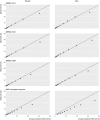Predicting the 10 year risk of cardiovascular disease in the United Kingdom: independent and external validation of an updated version of QRISK2
- PMID: 22723603
- PMCID: PMC3380799
- DOI: 10.1136/bmj.e4181
Predicting the 10 year risk of cardiovascular disease in the United Kingdom: independent and external validation of an updated version of QRISK2
Abstract
Objective: To evaluate the performance of the QRISK2-2011 score for predicting the 10 year risk of cardiovascular disease in an independent UK cohort of patients from general practice and to compare it with earlier versions of the model and a National Institute for Health and Clinical Excellence version of the Framingham equation.
Design: Prospective cohort study to validate a cardiovascular risk score with routinely collected data between June 1994 and June 2008.
Setting: 364 practices from the United Kingdom contributing to The Health Improvement Network (THIN) database.
Participants: Two million patients aged 30 to 84 years (11.8 million person years) with 93,564 cardiovascular events.
Main outcome measure: First diagnosis of cardiovascular disease (myocardial infarction, angina, coronary heart disease, stroke, and transient ischaemic attack) recorded in general practice records.
Results: Results from this independent and external validation of QRISK2-2011 indicate good performance data when compared with the NICE version of the Framingham equation. QRISK2-2011 had better ability to identify those at high risk of developing cardiovascular disease than did the NICE Framingham equation. QRISK2-2011 is well calibrated, with reasonable agreement between observed and predicted outcomes, whereas the NICE Framingham equation seems to consistently over-predict risk in men by about 5% and shows poor calibration in women.
Conclusions: QRISK2-2011 seems to be a useful model, with good discriminative and calibration properties when compared with the NICE version of the Framingham equation. Furthermore, based on current high risk thresholds, concerns exist on the clinical usefulness of the NICE version of the Framingham equation for identifying women at high risk of developing cardiovascular disease. At current thresholds the NICE version of the Framingham equation has no clinical benefit in either men or women.
Conflict of interest statement
Competing interests: All authors have completed the ICMJE uniform disclosure form at
Figures
Comment in
-
The risks in risk prediction.BMJ. 2012 Jun 21;344:e4215. doi: 10.1136/bmj.e4215. BMJ. 2012. PMID: 22723607 No abstract available.
-
Being sanguine about study design and multiple imputation.BMJ. 2012 Sep 10;345:e5884; author reply e5885. doi: 10.1136/bmj.e5884. BMJ. 2012. PMID: 22963936 No abstract available.
-
ACP Journal Club. QRISK2-2011 predicted cardiovascular disease in adult general practice patients.Ann Intern Med. 2012 Oct 16;157(8):JC4-12. doi: 10.7326/0003-4819-157-8-201210160-02012. Ann Intern Med. 2012. PMID: 23070514 No abstract available.
References
-
- World Health Organization. Cardiovascular diseases (CVDs). Fact sheet No 317. WHO, 2011. www.who.int.
-
- Department of Health. Putting prevention first—vascular checks: risk assessment and management. Department of Health, 2008.
-
- National Institute for Health and Clinical Excellence. Lipid modification: cardiovascular risk assessment and the modification of blood lipids for the primary and secondary prevention of cardiovascular disease. 2008.http://guidance.nice.org.uk/CG67. - PubMed
-
- Anderson KM, Odell PM, Wilson PWF, Kannel WB. Cardiovascular disease risk profiles. Am Heart J 1991;121:293-8. - PubMed
-
- Ridker PM, Buring JE, Rifai N, Cook NR. Development and validation of improved algorithms for the assessment of global cardiovascular risk in women: the Reynolds Risk Score. JAMA 1997;297:611-9. - PubMed
Publication types
MeSH terms
LinkOut - more resources
Full Text Sources



